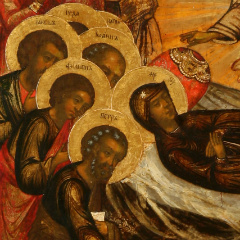
A woman sits in a church, her cheeks and breast wet with tears. She’s come from Sweden to this basilica in Saint-Maximin-la-Sainte-Baume, part of Provence, not far from the Mediterranean Sea. In Roman Catholic tradition, Mary Magdalene is believed to have come the region before her death. Her relics are preserved in the church, and the woman, Parvin Tavakol Olofsson, has come to sit near this disciple who so closely followed Christ and with whom she so closely identifies.
Olofsson was born a Muslim in Iran but later moved to Sweden and subsequently discovered Christianity. “In my home country,” she said, “all women are invisible in the shadow of power.” Her image and brief story is captured in the March 2012 National Geographic cover feature, “The Journey of the Apostles.”
I was touched by the image of this woman’s joyful tears and also the grim thought of her former life in Iran. Though it certainly has its more patriarchal practitioners, traditional Christianity differs from Islam in its open and ready celebration of women — something that brings hope and encouragement to many, particularly the marginalized and repressed.
Indeed, women stand out in the Gospels accounts. Not only were there several women mentioned in Christ’s genealogy, but women were counted among the disciples. Jesus’ female disciples stayed with him throughout the crucifixion while most of the men hid, and they were also the first to witness the empty tomb.
Perhaps no single woman exemplifies and embodies this point as well as Mary Magdalene, whose life was marked by thorough devotion to Christ. Delivered by Jesus from demonic control, Mary became a fervent disciple and followed him all the way to the cross. What’s more, she was the first of the disciples to see him on the morning of the resurrection, having come early in the morning to ensure her Lord’s body was properly prepared for burial. Recognized as a saint, the church additionally provides Mary Magdalene with the rare title, “Equal to the Apostles.”
Others in the Gospels stand out as well: Mary of Bethany and her sister, Martha; Salome, mother of James and John; Peter’s wife and mother-in-law; and the woman at the well, remembered in the tradition as Photina, also “Equal to the Apostles.” This is to mention nothing of others outside the Gospels such as Priscilla and Mary the mother of John Mark.
And then, of course, there is Jesus’ own mother. Devout, humble, contemplative, prayerful Mary is an oversight for some Christians today, but she was dear to the disciples and the early church. A central figure in the Jerusalem church, at Mary’s repose, the apostles returned from their various missionary sojourns (all except Thomas, who was late just like he’d been to earlier appearance of the resurrected Jesus). Icons of the event show these men pressing around the bed on which the dear saint, their precious lady, reclined at her death.
What started in the early church has continued through the centuries. Woman martyrs have, for instance, been celebrated in hymns and remembered in litanies. To this day the supplicatory litany in the Orthodox church recalls, “the holy, glorious, great women martyrs: Thekla, Barbara, Anastasia, Katherine, Kyriaki, Photeini, Marina, Paraskeva, and Irene.” And these are only but a few. The lists of saints are full of the names of women who loved the Lord and whose lives exemplify faith and hope to men and women today.
The church is a room full of sisters, and Christians have celebrated the fact down to the present day. When we run into those who do not, we should remind them that Jesus elevated women and their labors have been essential to the spread of the Gospel from the start.












